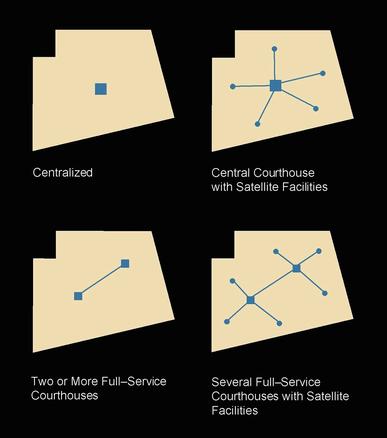 |
|
Consolidation vs. Separation of Court Facilities |
Local governments frequently face the problem of deciding whether to maintain consolidated judicial facilities or to separate functions among several locations. Many large municipalities and counties maintain multiple locations as a matter of necessity. Conversely, very small jurisdictions may never need to consider separating judicial functions among multiple facilities. Most city and county governments, however, fall somewhere between the two extremes and must confront this issue.
In Favor of Decentralization: Public Convenience
For criminal misdemeanors, minor civil cases and traffic court, many jurisdictions try to provide court services within about twenty minutes' driving time as a convenience for the public.
In Favor of Centralization: Economy and Operational Efficiency
It is generally more expensive and less efficient to build and maintain multiple facilities than to consolidate operations within a single facility.
At the limited jurisdiction and traffic court level, public convenience and the different nature of limited jurisdiction courts often lead to some separation of judicial functions. Off-site payment booths for the payment of uncontested parking and traffic violations are sometimes used as an alternative to, or in conjunction with, satellite facilities. Another factor encouraging the use of satellite facilities for limited jurisdiction cases is that judges often can operate easily with minimal support staff in satellite facilities. As the range of cases heard in a satellite facility expands, however, so does the demand for clerical and other staff support. General jurisdiction cases generally re quire more resources, in the form of large jury panels, prosecuting attorneys, public defenders or private defense attorneys, probation officers, prisoner custody personnel, and others. These are in addition to regular clerical and trial staff. The trial staff may consist of some combination of courtroom clerks, bailiffs, law clerks, and court reporters. Neither transporting these participants on an occasional basis nor permanently housing all of these functions in a satellite facility may represent a particularly desirable solution for general jurisdiction courts.
Assembling jurors at or transporting jurors to multiple locations presents severe logistical difficulties and is typically avoided by all but the largest jurisdictions. Dividing general jurisdiction judges among separate locations can interfere with the efficient operation of both specialized trial divisions and centralized calendaring systems. Further, specialized clerical and support staff time may not be efficiently used at satellite locations, unless caseloads are usually uniform and predictable.
Two considerations make consolidation versus separation a difficult issue, particularly for full service facilities:
Duplication of Function
Space for functions such as law libraries, central prisoner-holding units, and jury assembly areas invariably may be duplicated at multiple general jurisdiction facilities, and duplication of functions has implications for both initial capital and on going operating costs.
Unpredictable Growth of Specialized Caseloads
Specialized caseloads grow unpredictably, particularly within specific geographical locations of a city or county. Given some overall consistency in system-wide growth, a single facility can flexibly respond to ebbs and flows in civil and criminal cases, or to demographic shifts within the jurisdiction. Multiple facilities may experience too much growth in one area and too little in another. Not having the right amount of space in the right place and at the right time is frustrating, especially for jurisdictions with multiple facilities.
Most jurisdictions falling within the two extremes of size have addressed the consolidation/separation issue by limiting the functions of satellite facilities and maximizing centralized functions. Issues such as effective and efficient use of judges, staff utilization and supervision, juror pooling and summonsing, uniformity of process and procedure, and differential growth within the jurisdiction have led most communities to consolidate general trial court functions and as many limited court functions as possible, depending on overall size and geographical makeup. In planning new and renovated facilities, great care should be taken to consider the long-term advantages and disadvantages of consolidation and separation.
Multi-Jurisdictional / Regional Facilities
While it is fairly common for multiple jurisdictions to share jails and prisons, it is not often done with judicial facilities. There are, however, a number of situations where localities might consider regional, or multi jurisdictional, court facilities; for example, several local jurisdictions in Virginia have shared city/county courthouses. While this might not seem unusual, cities in Virginia are administratively independent entities. It would be as if two neighboring counties in Kansas built and shared a courthouse. A more typical situation would be if a city municipal court and a county general jurisdiction court were to share a single court facility. Another example is the Salt Lake City Courthouse, which houses the trial courts for Salt Lake County as well as the state's appellate courts and administrative offices. Another area of inter-jurisdictional cooperation might involve state and federal courts. Such cooperation might be particularly useful where one of the jurisdictions builds extra capacity, which it leases to the other until it is needed in the more distant future. While these examples may not be applicable in most situations, their consideration in the proper situation may lead to considerable savings.
